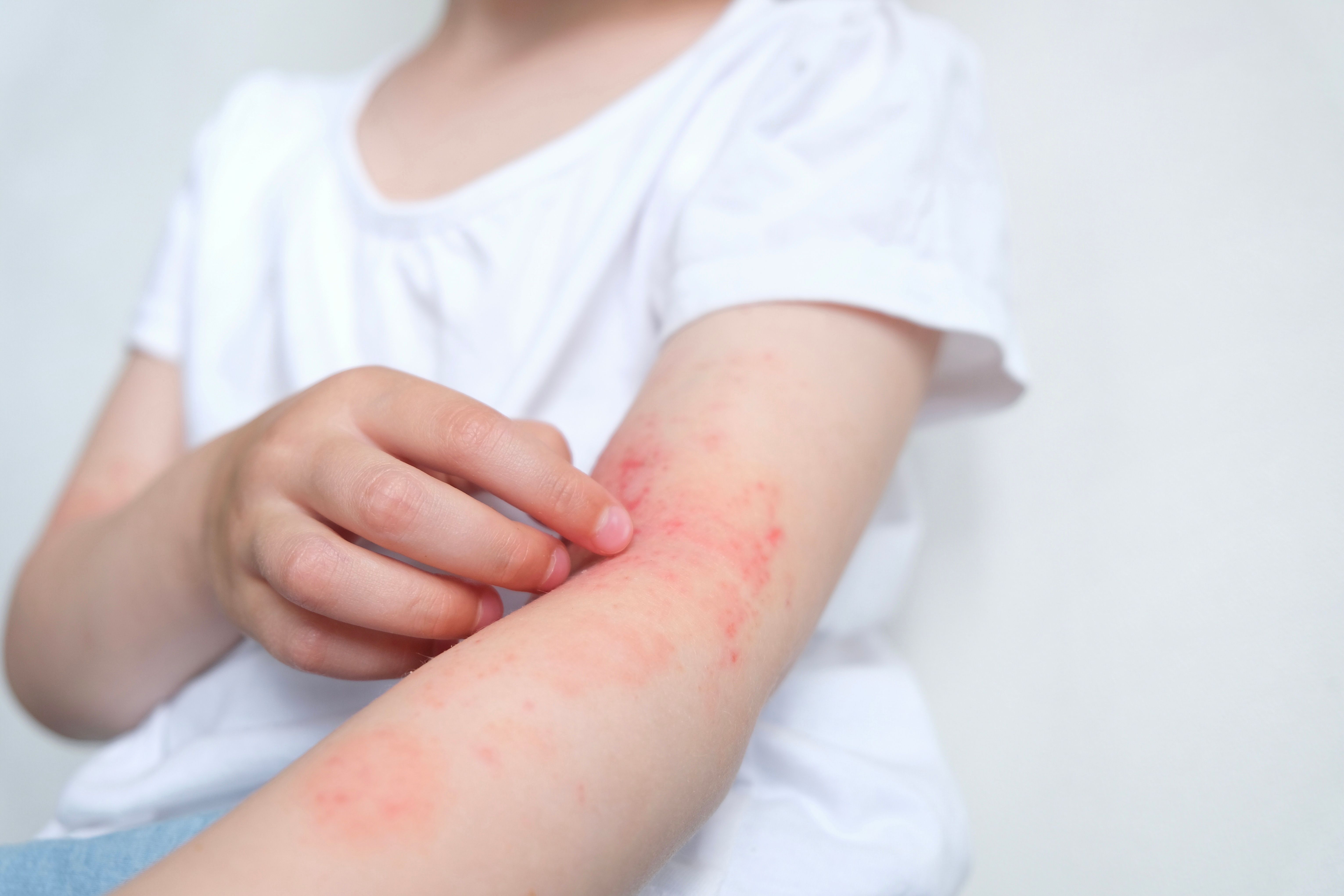Children with TNF inhibitor-induced psoriasiform eruptions may continue TNF inhibitors
Research was conducted on the paradoxical effect of TNF inhibitor–induced psoriasiform eruption in children and adolescents treated with inhibitors for conditions other than psoriasis.
Child scratching skin | Image Credit: © Марина Терехова - © Марина Терехова- stock.adobe.com.

A majority of children who have tumor necrosis factor α (TNF) inhibitor–induced psoriasiform eruptions may continue TNF inhibitor treatment facilitated by adjuvant skin eruption therapies, according to new findings.1
While it has been well-established that the paradoxical psoriasiform eruptions that are TNF inhibitor-induced can occur in adults, there are only a small number of documented cases of this effect in children.2
Joshua Eickstaedt, MD, known for his work at the Department of Dermatology at the University of Wisconsin School of Medicine and Public Health, authored this current study examining the cases in younger patients further.
“Recent studies suggest a similar adverse effect in children, but, to our knowledge, information has been limited to case reports and small single-center case series focused primarily on TNF inhibitor use for inflammatory bowel disease (IBD),” Eickstaedt and colleagues wrote.
Consequently, this study was conducted to evaluate the clinical features as well as the clinical time course of these eruptions in pediatric patients.
Background and Findings
The investigators conducted a retrospective case series of pediatric patients under 18 years old who had developed a psoriasiform eruption while taking TNF inhibitors for non-dermatologic diseases. Their study covers the period from January of 2000-December of 2016.
The investigators gathered clinical data on patients who had been prescribed the TNF inhibitors for various conditions and had, consequently, experienced psoriasiform eruptions (a skin condition that resembles psoriasis) as a side effect.
The data the researchers decided to take note of in their research included the following:
- The demographics of patients
- Eruption location on patients’ bodies
- Biopsy results
- Treatment patients were given to manage eruptions
The investigators also reported on any changes to the initial TNF inhibitor, subsequent therapies for the primary disease, and patients’ development of recurrent eruptions. Recurrent eruptions were defined as the reappearance of the skin condition following the initial treatment with a TNF inhibitor was stopped and following the beginning of a second-line TNF inhibitor.
In their research, the team included data collected from multiple medical centers affiliated with the Pediatric Dermatology Research Alliance, and they entered the data into a Research Electronic Data Capture database at the Mayo Clinic, which was the coordinating center.
The research team identified eruptions in 103 total patients who had been treated with TNF inhibitors, and the group had a median age of 13.8 years. Additionally, the team noted that 65% had been treated with infliximab.
Most of the patients in the study showed no personal or family history of psoriasis, and inflammatory bowel disease was the most common indication for their treatment. Psoriasiform eruptions were found by the investigators to have occurred at multiple sites, with scalp involvement being the most common.
The investigators commented on several other important findings, such as that tpical medication was prescribed for all patients, and systemic therapy was added for 29% of patients. They also noted that 25% of patients had suboptimal effectiveness with topical medication alone, prompting a change to a second-line TNF inhibitor.
This, the researchers found, improved skin disease in 88% of patients, although 31% of patients who started a second-line TNF inhibitor developed a subsequent TNF inhibitor–induced psoriasiform eruption.
Lastly, the research team noted that 17% of patients discontinued all TNF inhibitors due to persistent skin disease, 11 changed to a non-TNF inhibitor systemic therapy, and 7 stopped all systemic therapies.
“Infliximab is the most common TNF inhibitor associated with this reaction in children, although there does appear to be a class effect,” they wrote. “Most of the children were able to continue TNF inhibitor treatment with skin-directed and other adjuvant therapies, although the discontinuation of a TNF inhibitor may be required in recalcitrant cases.”
References
- Eickstaedt J, Paller AS, Lund E, et al. Paradoxical Psoriasiform Eruptions in Children Receiving Tumor Necrosis Factor α Inhibitors. JAMA Dermatol. Published online April 12, 2023. doi:10.1001/jamadermatol.2023.0549.
Wollina U, Hansel G, Koch A, Schönlebe J, Köstler E, Haroske G. Tumor necrosis factor-alpha inhibitor-induced psoriasis or psoriasiform exanthemata: first 120 cases from the literature including a series of six new patients. Am J Clin Dermatol. 2008;9(1):1-14. doi:10.2165/00128071-200809010-00001.
This article was initially published by our sister publication, HCP Live.
Recognize & Refer: Hemangiomas in pediatrics
July 17th 2019Contemporary Pediatrics sits down exclusively with Sheila Fallon Friedlander, MD, a professor dermatology and pediatrics, to discuss the one key condition for which she believes community pediatricians should be especially aware-hemangiomas.
Itchy skin associated with sleep problems in infants
September 27th 2024A recent study presented at the American Academy of Pediatrics 2024 National Conference & Exhibition, sheds light on the connection between skin conditions and sleep disturbances in infants and toddlers, highlighting itchy skin as a significant factor, even in the absence of atopic